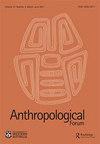灭绝,铭文和梦想:探索袋狼的联系
IF 0.7
3区 社会学
Q3 ANTHROPOLOGY
引用次数: 1
摘要
袋狼通常与塔斯马尼亚的灭绝有关,它们也存在于澳大利亚大陆,直到3000-3500年前,在澳大利亚各地的岩石艺术遗址中都有描绘。灭绝后的漫长时期意味着我们对澳大利亚土著与这种动物的联系知之甚少。本文利用现有证据来探索袋狼之间的联系。这一探索突出了铭文、痕迹和叙述在促进与长期灭绝的物种的持续关系中可能发挥的作用。它还表明,在这些宇宙论中,一个物种的物质缺失并不一定与本体论的终结(通常被认为是灭绝思想的核心)有关。这里提供的比较视角补充了详细描述灭绝作为一个概念的工作,它有自己的历史起源和发展,作为对世界本质及其居民的特定文化理解而出现。本文章由计算机程序翻译,如有差异,请以英文原文为准。
Extinction, Inscription and the Dreaming: Exploring a Thylacine Connection
ABSTRACT The thylacine, commonly associated with its Tasmanian extinction, also existed on the Australian mainland up until 3000–3500 years ago and is depicted in rock art sites in various locations around Australia. This lengthy period since extinction means we know little about Aboriginal Australians’ connections with this animal. This paper draws on available evidence to explore these thylacine connections. This exploration highlights the role that inscriptions, traces and narratives may play in facilitating continuing relationships with long extinct species. It also suggests that in these cosmologies, the material absence of a species does not necessarily correlate with ontological finality (of the kind generally considered central to the idea of extinction). The comparative perspective offered here complements work detailing extinction as a concept that has its own historical origins and developments, one that emerges as a specific cultural understanding about the nature of the world and its inhabitants.
求助全文
通过发布文献求助,成功后即可免费获取论文全文。
去求助
来源期刊

Anthropological Forum
ANTHROPOLOGY-
CiteScore
3.60
自引率
10.00%
发文量
14
期刊介绍:
Anthropological Forum is a journal of social anthropology and comparative sociology that was founded in 1963 and has a distinguished publication history. The journal provides a forum for both established and innovative approaches to anthropological research. A special section devoted to contributions on applied anthropology appears periodically. The editors are especially keen to publish new approaches based on ethnographic and theoretical work in the journal"s established areas of strength: Australian culture and society, Aboriginal Australia, Southeast Asia and the Pacific.
 求助内容:
求助内容: 应助结果提醒方式:
应助结果提醒方式:


